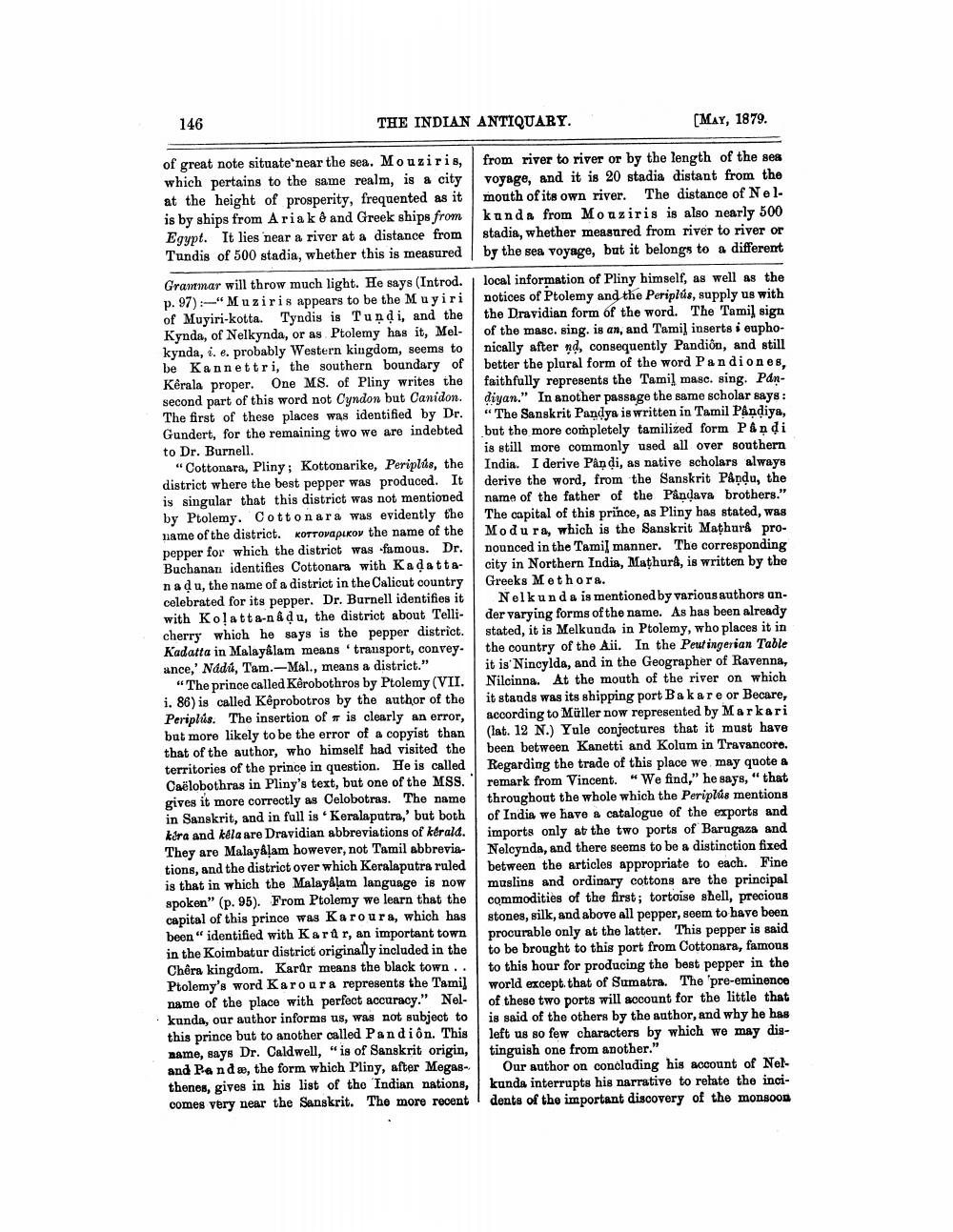________________
146
THE INDIAN ANTIQUARY.
[MAY, 1879.
of great note situate near the sea. Mouziris, which pertains to the same realm, is a city at the height of prosperity, frequented as it is by ships from Aria k ê and Greek ships from Egypt. It lies near a river at a distance from Tundis of 500 stadia, whether this is measured Grammar will throw much light. He says (Introd. p. 97):-"Muziris appears to be the Muyiri of Muyiri-kotta. Tyndis is Tundi, and the Kynda, of Nelkynda, or as Ptolemy has it, Mel kynda, i. e. probably Western kingdom, seems to be Kannettri, the southern boundary of Kerala proper. One MS. of Pliny writes the second part of this word not Cyndon but Canidon. The first of these places was identified by Dr. Gundert, for the remaining two we are indebted to Dr. Burnell.
"Cottonara, Pliny: Kottonarike, Periplus, the district where the best pepper was produced. It is singular that this district was not mentioned by Ptolemy. Cottonara was evidently the name of the district. KOTTOVapukoy the name of the pepper for which the district was famous. Dr. Buchanan identifies Cottonara with Kadattanadu, the name of a district in the Calicut country celebrated for its pepper. Dr. Burnell identifies it with Kolatta-nadu, the district about Tellicherry which he says is the pepper district. Kadatta in Malayalam means transport, convey. ance,' Nádú, Tam.-Mal., means a district."
"The prince called Kêrobothros by Ptolemy (VII. i. 86) is called Képrobotros by the author of the Periplús. The insertion of is clearly an error, but more likely to be the error of a copyist than that of the author, who himself had visited the territories of the prince in question. He is called Caëlobothras in Pliny's text, but one of the MSS. gives it more correctly as Celobotras. The name in Sanskrit, and in fall is 'Keralaputra,' but both kira and kéla are Dravidian abbreviations of kérald. They are Malay&ļam bowever, not Tamil abbreviations, and the district over which Keralaputra ruled is that in which the Malayalam language is now spoken" (p. 95). From Ptolemy we learn that the capital of this prince was Karoura, which has been" identified with Karar, an important town in the Koimbatur district originally included in the Chêra kingdom. Kardr means the black town .. Ptolemy's word Karoura represents the Tamil name of the place with perfect accuracy." Nelkunda, our author informs us, was not subject to this prince but to another called Pandion. This name, says Dr. Caldwell, "is of Sanskrit origin, and Pandæ, the form which Pliny, after Megas- thenes, gives in his list of the Indian nations, comes very near the Sanskrit. The more recent
from river to river or by the length of the sea voyage, and it is 20 stadia distant from the mouth of its own river. The distance of Nel. kunda from Mouziris is also nearly 500 stadia, whether measured from river to river or by the sea voyage, but it belongs to a different local information of Pliny himself, as well as the notices of Ptolemy and the Periplús, supply us with the Dravidian form of the word. The Tami, sign of the masc. sing. is an, and Tamil inserts i euphonically after nd, consequently Pandion, and still better the plural form of the word Pandiones, faithfully represents the Tamil masc. sing. Pandiyan." In another passage the same scholar says: “The Sanskrit Pandya is written in Tamil Pandiya, but the more completely tamilized form Pandi is still more commonly used all over southern India. I derive Pandi, as native scholars always derive the word, from the Sanskrit Papu, the name of the father of the Påndava brothers." The capital of this prince, as Pliny has stated, was Modura, which is the Sanskrit Mathura pronounced in the Tamil manner. The corresponding city in Northern India, Mathurd, is written by the Greeks Methora.
Nolkunda is mentioned by various authors onder varying forms of the name. As has been already stated, it is Melkunda in Ptolemy, who places it in the country of the Aii. In the Peut ingerian Table it is Nincylda, and in the Geographer of Ravenna, Niloinna. At the mouth of the river on which it stands was its shipping port Bakare or Becare, according to Müller now represented by Markari (lat. 12 N.) Yule conjectures that it must have been between Kanetti and Kolum in Travancoro. Regarding the trade of this place we may quote a remark from Vincent. "We find," he says, "that throughout the whole which the Periplús mentions of India we have a catalogue of the exports and imports only at the two ports of Barugaza and Neloynda, and there seems to be a distinction fixed between the articles appropriate to each. Fine muslins and ordinary cottons are the principal commodities of the first; tortoise shell, precious stones, silk, and above all pepper, seem to have been procurable only at the latter. This pepper is said to be brought to this port from Cottonara, famous to this hour for producing the best pepper in the world except that of Sumatra. The 'pre-eminence of these two ports will account for the little that is said of the others by the author, and why he has left us so few characters by which we may distinguish one from another."
Our author on concluding his account of Nelkunda interrupts his narrative to relate the incidents of the important discovery of the monsoon




